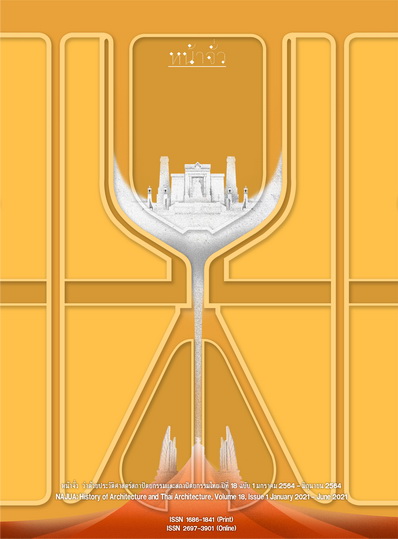Infrastructure Plan for Urban Development during King Rama VII’s Reign: Western Seaside Resorts Development Act 1926
Main Article Content
Abstract
The purpose of this study aims to investigate the evolution of infrastructure development for urban planning during the reign of King Prajadhipok (Rama VII) under the Western Seaside Resort Development Act B.E. 2469. The important factors that led to the establishment of the Western Seaside Resort Development Council were: (1) shortage of clean water due to the residential density in Hua Hin; and (2) tourism’s rapid growth after the operation of the southern railway passed through and linked to the international railways. The council was initially set up as a form of local government and functioned as a legal entity with its roles to manage infrastructure within their management area from the main Cha-am to Hua Hin. The council intended to develop Hua Hin to a leading international seaside resort town. Its projects involved infrastructure such as roads construction, electricity, water supply, school and hospital.
Therefore, this study would like to analyze the operation of the council based on the international standards. The findings reveal that the establishment of the council was a breakthrough evolution in modern urban planning since it was set up for infrastructure and town planning projects in Thailand. However, the operation could not be defined as the concept of municipality and local government existed in other western countries as all council committees were elected by the central government instead of the local resident.
King Prajadhipok had foreseen that the urban planning is part of the municipality. In addition to the collection of a property tax for infrastructure development, there was a local road tax. These taxes were coherent with the concept of Beneficiary-pays principle which is the same principle used in the expressway development project nowadays. However, this principle was ahead of its time as a modern infrastructure like this has not yet been established in Thailand at that time.
In conclusion, Cha-am and Hua Hin was known for the most modern resort destination of that time in which the operation run by the council was also recognized as the most outstanding evolution of infrastructure development in Thailand.
Downloads
Article Details

This work is licensed under a Creative Commons Attribution-NonCommercial-NoDerivatives 4.0 International License.
References
Brookby Quarries Ltd. Replacement land use consent and S127 consent application to modify the discharge to air consent–assessment of effects on the environment. Accessed November 11, 2019. Available from http://www.brookbyquarry.co.nz/site/brookbyquarry/Volume%20Two%20of%20Two%20AEE.pdf
Bundit Chulasai. hōten hūa hin hǣng Sayām prathēt [Hua-hin train station hotel of Thailand]. Bangkok: Chulalongkorn University Printing House, 1998.
Chanchai Rattanavibul. “botbāt khō̜ng ʻaphiratthamontrī saphā nai ratchasamai Phrabāt Somdet Phra Pokklao Čhaoyūhūa [The role of the supreme council of state in the reign of King Prajadhipok].” Master Thesis, Srinakarintraviroj University, 1976.
Ebenezer Howard. Garden cities of to-morrow, 2nd ed. London: S. Sonnenschein & Co, 1902.
Joint Committee on Culture, Heritage and the Gaeltacht. Sustaining viable rural community. Accessed November 11, 2019. Available from https://data.oireachtas.ie/ie/oireachtas/committee/dail/32/joint_committee_on_culture_heritage_and_the_gaeltacht/reports/2017/2017-11-30_reportsustaining-viable-rural-communities_en.pdf
Kannika Tanprasert. čhotmāihēt wang klai kangwon samai ratchakān thī čhet [Archives of Klai Kang Won Palace in the reign of King Prajadhipok]. Bangkok: Matichon Press, 2003.
Orathai Kokphol. Urbanization: mư̄a mư̄ang klāi pen čhōt khō̜ng kānbō̜rihān čhatkān thō̜ngthin samai mai [Urbanization: When city becomes the topic of modern local administration]. Bangkok: King Prajadhipok's Institute, 2016.
Panpun Ronghanam. “wiwatthanākān kān phangmư̄ang khō̜ng prathēt Thai [Evolution of urban planning of Thailand].” NAJUA: History of Architecture and Thai Architecture, no. 12, (January-December 2015): 250-271.
Phinyapan Phojanalawan. thētsabān: phư̄nthī mư̄ang læ kān wēlā [Municipality: Space, City and Time]. Bangkok: Siam Press, 2017.
“phrarātchabanyat čhangkō̜p nai khē čhat bamrung sathānthī chāithalē thit tawantok Phō̜.Sō̜. 2471 [Taxation Act 1926].” Thai government gazette, no.45 (5th August 1926): 122.
“phrarātchabanyat kān čhat bamrung sathānthī chāithalē thit tawantok Phō̜.Sō̜. 2469 [Western Seaside Resorts Development Act 1926].” Thai government gazette, no.43 (18th October 1926): 53.
“phrarātchakrisadika wa duai kan chad sue thi din læ asangharimmasub yang auen phuea kan prapa faifa bam rung kan khamanakhom læ wang phan phang khrong kan čhat bamrung sathānthī chāithalē thit tawantok Phō̜.Sō̜. 2473 [The decree of land acquisition and properties for water supply, electricity, maintenance, transportation and urban planning in Western Seaside Resorts Development Project, 1930].” Thai government gazette, no.47 (1st February 1930): 353.
Pruetisarn Chumpol, M.R. hūa hin læ wang klai kangwon nai samai ratchakān thī čhet [Hua-hin and Klai Kang Won Palace in the Reign of King Prajadhipok]. Accessed October 17, 2019. Available from http://kingpraja dhipokstudy.blogspot.com/2010/06/7_26.html
“rư̄ang phrarātchabanyat čhat bamrung sathānthī chāithalē thit tawantok kap rư̄ang tang tamnǣng nāyok kammakān læ thīprưksā khō̜ng saphā čhat bamrung sathānthī chāithalē [Western Seaside Resorts Development Act and the establishment of the Council Mayor, Committees and Advisors].” 1926-1931. Office of His Majesty's PrincipalPrivate Secretary King Rama VII. Ministry of Interior. ร.7 รล. มท. 1/275. National Archives of Thailand.
Sakon Waranyawattana. “withī mai kānphatthanā rāirap thō̜ngthin Thai [New way of Thai local revenue development].” Academic Document no. 75, Local College of King Prajadhipok Institute, 2011.
Sondhi Tejanant. phǣn phatthanākān mư̄ang pai sū kān pokkhrō̜ng rabō̜p prachāthipatai tām nǣo phrarāt chadamri khō̜ng Phrabāt Somdet Phra Pokklao Čhaoyūhūa (Phō̜.Sō̜. 2469-2475) [Political movement to democratic regime in the reign of King Rama VII (1926-1932)]. Nonthaburi: King Prajadhipok’s Institute, 2002.
Suwasadee Photpun. “thētsabān læ phonkrathop tō̜ ʻamnāt thō̜ngthin Phō̜.Sō̜. 2476-2500 [Municipality and its impacts on local power, 1933-1957].” Master Thesis, Chulalongkorn University, 2000.
Thamrongsak Petchlert-anan. 2475 læ nưng pī lang kān patiwat [1932 revolution and the aftermath]. Bangkok: Institute of Asian Studies, Chulalongkorn University and The Foundation for the Promotion of Social Sciences and Humanities Texbooks Projects, 2000.


